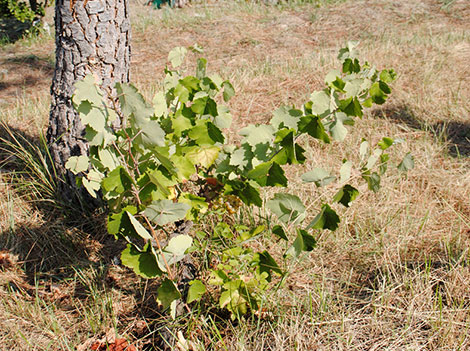A better future for Spanish wines with pre-phylloxera grapes?

“Relevant information for winegrowers. If you know of any grape variety apart from the standard ones (Xarel.lo, Parellada, Ull de Llebre, Cabernet, Merlot, Sumoll or Garnacha) or anyone growing them, please contact Bodegas Torres.”
This ad published in the local Regiò7 newspaper in 2000 was one of many used by Bodegas Torres since the mid-1980s to track samples of pre-phylloxera grape varieties in Catalonia. The project was championed by current president Miguel A. Torres, who followed the advice of Monsieur Boubals, his teacher at Montpellier University in France.
For over three decades the technical team at Torres has been answering calls from winegrowers claiming to have identified a rare, unknown variety. “In many cases, it was just Tempranillo, Sumoll or Trepat”, explained Josep Sabarich, technical director at Bodegas Torres, in the course of a tasting held at Enofusión wine fair in Madrid last month. “Are we capable of making pleasant wines from grapes grown by our great-grandfathers?” he wondered.
The content of our glasses quickly tipped the balance to a clear yes. But impressive as it was to taste these ancient flavours, I was struck by the strenuous, long process behind. Torres has carried out a Herculean task, perhaps expected from a public institution rather than from a private company.
Thirty years of hard work
Recovering these old grapes has been a painstaking process. After identifying a rare plant, DNA tests are carried out to verify that it is indeed an unknown variety. Afterwards researchers must obtain virus-free material, replicate it in vitro, then in greenhouses and finally grow the new variety outdoors. Researchers still need some time to find grapes which are suitable to be vinified and turned into wine whose quality and characteristics will in turn need to be evaluated.
Garró was the first variety discovered by Torres. It was found in terraced vineyards in the Garraf mountains (Penedès) in the mid-1980s and was planted in the Conca de Barberà appellation in Tarragona in time to be part of the blend of Grans Muralles 1996, the wine’s first vintage. After the officially required three-year testing period was completed, Garró was added to Spain’s Register of Commercial Vine Varieties in 2011. According to grape expert Félix Cabello, Garró happens to be the same as Mandó, a variety which is currently being recovered in several areas of Catalonia and southeast Spain but had never made its way to the country’s official register.
Querol, the second variety recovered by Torres, was added to the 2009 blend of Grans Muralles to bring freshness and grip and to offset the high ripeness levels found in many vintages in this hot, Mediterranean region. Querol now accounts for 20% of the Grans Muralles blend. The wine was the most tannic and concentrated of the range, showing consistency and power. As a curiosity, some bunches present a mix of medium and very small, pea-sized berries (see photo above) due to fecundation problems.
Mediterranean varieties
This archaeological-like search has resulted in the identification of over 50 unknown grape varieties, but according to Sabarich, only two whites and around four to five reds show real potential. The research has been done in partnership with INRA, the French National Institute for Agricultural Research, whereas DNA tests were compared against data provided by Montpellier’s Vine Collection.
Almost all of the varieties are resistant to drought and high temperatures, proving a great tool in the fight against climate change. Other shared features are the small size of the berries –the lower correlation between must and skins is a key quality factor– and the good levels of acidity.
Sabarich thinks that their lively, fresh profile is a consequence of the dehydration taking place on the final stages of the ripening process. As a result, the berries undergo a concentration process that not only affects sugar but also acidity. In the case of Gonfaus, a grape found in an area halfway between the districts of Bages and Ossona in Central Catalonia, it produces a powerful red wine rich in acidity and structure with a considerable middle-palate rather than harsh tannins. Sabarich is convinced that winegrowers gave up planting this grape variety because of its poor fruit set and low yields –two features that explain the high levels of concentration in the wine even if the skins were removed almost immediately after fermentation was completed.
Torres is growing Gonfaus in the Desterrados estate in Aranyó (Costers del Segre), a dry, unirrigated land where the red wine Purgatori is produced. Another recovered red variety called Moneu is also grown here. It is quite consistent and shows good levels of acidity but the wine feels more refined with distinctive Mediterranean herbs on the finish.
Shared findings
The Torres family is willing to share the results of their research with other winegrowers and give away cuttings or plant material for reproduction. Miguel Torres Jr. firmly believes that this is the way to go and, in fact, some winegrowers in Penedès have already planted Forcada.
The only white grape in the presentation, it was named after one of the mountains surrounding the place where it was found in the Garrotxa district, near the village of Ripoll and the Pyrenees. The wine had a striking citrus acidity delineating the palate. Forcada has been planted in Fransola, one of the highest estates owned by the family in Penedès at 450m above sea level.
The last wine we tasted was Pirene, a red grape found near Cervera in the province of Lleida and named for is suitability to be grown in the Pyrenees. In fact, it already thrives in Tremp, the family’s northernmost property in Catalonia. The wine showed some degree of rusticity with aromas of small forest berries and fine tannins.
Last year, three additional varieties were included in the Register of Commercial Vine Varieties at the request of Torres. Coromina shows potential for distillation purposes and to be transformed into high quality brandy, a product with a long standing tradition in the family, but the technical department says some more harvests are needed to assess its real potential. Solana and Bronsa are still under research.

Amaya Cervera
A wine journalist with almost 30 years' experience, she is the founder of the award-winning Spanish Wine Lover website. In 2023, she won the National Gastronomy Award for Gastronomic Communication
Wine tastings in March 2017
NEWSLETTER
Join our community of Spanish wine lovers






